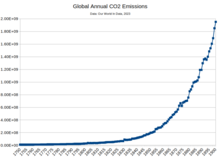



Industrialisation (UK) or industrialization (US) is the period of social and economic change that transforms a human group from an agrarian society into an industrial society. This involves an extensive reorganisation of an economy for the purpose of manufacturing.[3] Industrialisation is associated with increase of polluting industries heavily dependent on fossil fuels. With the increasing focus on sustainable development and green industrial policy practices, industrialisation increasingly includes technological leapfrogging, with direct investment in more advanced, cleaner technologies.
The reorganisation of the economy has many unintended consequences both economically and socially. As industrial workers' incomes rise, markets for consumer goods and services of all kinds tend to expand and provide a further stimulus to industrial investment and economic growth. Moreover, family structures tend to shift as extended families tend to no longer live together in one household, location or place.
- ^ Bairoch, Paul (1995). Economics and World History: Myths and Paradoxes. University of Chicago Press. p. 95. ISBN 978-0-226-03463-8. Archived from the original on 27 September 2022. Retrieved 7 July 2021.
- ^ "Annual CO₂ emissions". Our World in Data. Archived from the original on 31 March 2024.
- ^ O'Sullivan, Arthur; Sheffrin, Steven M. (2003). Economics: Principles in Action. Upper Saddle River, New Jersey: Pearson Prentice Hall. p. 472. ISBN 0-13-063085-3. OCLC 50237774.